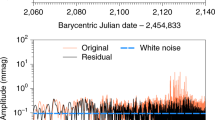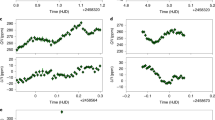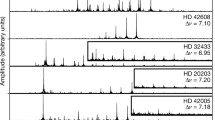Abstract
Pressure-driven (p-mode) oscillations at the surface of the Sun, resulting from sound waves travelling through the solar interior, are a powerful probe of solar structure, just as seismology can reveal details about the interior of the Earth. Astronomers have hoped to exploit p-mode asteroseismology1 in Sun-like stars to test detailed models of stellar structure and evolution, but the observations are extremely difficult. The bright star Procyon has been considered one of the best candidates for asteroseismology, on the basis of models and previous reports2,3,4,5,6,7,8 of p-modes detected in ground-based spectroscopy. Here we present a search for p-modes in 32 days of nearly continuous photometric satellite-based observations of Procyon. If there are p-modes in Procyon, they must have lifetimes less than 2–3 days and/or peak amplitudes <15 parts per million, which defy expectations from the Sun's oscillations and previous theoretical predictions. Target selection for future planned asteroseismology space missions may need to be reconsidered, as will the theory of stellar oscillations.
This is a preview of subscription content, access via your institution
Access options
Subscribe to this journal
Receive 51 print issues and online access
$199.00 per year
only $3.90 per issue
Buy this article
- Purchase on Springer Link
- Instant access to full article PDF
Prices may be subject to local taxes which are calculated during checkout




Similar content being viewed by others
References
Brown, T. M. & Gilliland, R. L. Asteroseismology. Annu. Rev. Astron, Astrophys. 32, 37–82 (1994)
Walker, G. A. H. et al. The MOST asteroseismology mission: Ultraprecise photometry from space. Publ. Astron. Soc. Pacif. 115, 1023–1035 (2003)
Green, D., Matthews, J. M., Seager, S. & Kuschnig, R. Scattered light from close-in extrasolar planets: Prospects of detection with the MOST satellite. Astrophys. J. 597, 590–601 (2003)
Girard, T. M. et al. A redetermination of the mass of Procyon. Astrophys. J. 119, 2428–2436 (2000)
Kervella, P. et al. The diameter and evolutionary state of Procyon A. Astron. Astrophys. 413, 251–256 (2004)
Allende Prieto, C., Asplund, M., Garcia López, R. J. & Lambert, D. L. Signatures of convection in the spectrum of Procyon: Fundamental parameters and iron abundance. Astrophys. J. 567, 544–565 (2002)
Chaboyer, B., Demarque, P. & Guenther, D. B. The pulsation properties of Procyon A. Astrophys. J. 525, 41–44 (1999)
Guenther, D. B. et al. Standard solar model. Astrophys. J. 387, 372–393 (1992)
Guenther, D. B. & Brown, K. I. T. Matching stellar models to oscillation data. Astrophys. J. 600, 419–434 (2004)
Gelly, B., Grec, G. & Fossat, E. Evidence for global pressure oscillations on Procyon. Astron. Astrophys. 164, 383–394 (1986)
Brown, T. M. et al. Detection of possible p-mode oscillations on Procyon. Astrophys. J. 368, 599–609 (1991)
Innis, J. L. et al. High-precision velocity observations of Procyon A – I. Search for p-mode oscillations from 1988, 1989 and 1990 observations. Mon. Not. R. Astron. Soc. 249, 643–653 (1991)
Mosser, B., Millard, J. P., Mékarnia, D. & Gay, J. New limit on the p-mode oscillations of Procyon obtained by Fourier transform seismometry. Astron. Astrophys. 340, 457–462 (1998)
Martić, M. et al. Evidence for global pressure oscillations on Procyon. Astron. Astrophys. 351, 993–1002 (1999)
Carrier, F., Bouchy, F., Kienzle, F. & Blecha, A. in Radial and Nonradial Pulsations as Probes of Stellar Physics (eds Aerts, C., Bedding, T. R. & Christensen-Dalsgaard, J.) 468–469 (Astronomical Society of the Pacific, San Francisco, 2002)
Martić, M., Lebrun, J.-C., Appourchaux, T. & Korzennik, S. G. P-mode frequencies in solar-like stars: I. Procyon A. Astron. Astrophys. (in the press)
Christensen-Dalsgaard, J. & Frandsen, S. Stellar 5-minute oscillations. Sol. Phys. 82, 469–486 (1983)
Houdek, G., Balmforth, N. J., Christensen-Dalsgaard, J. & Gough, D. O. Amplitudes of stochastically excited oscillations in main-sequence stars. Astron. Astrophys. 351, 582–596 (1999)
Samadi, R., et al. in First Eddington Workshop on Stellar Structure and Habitable Planet Finding (eds Favata, F., Roxburgh, I. W. & Galaí-Enríques, D.) 87–94 (ESA SP-485, ESA Publications Division, Noordwijk, 2002)
Kjeldsen, H. & Bedding, T. R. Amplitudes of stellar oscillations: The implications for asteroseismology. Astron. Astrophys. 293, 87–106 (1995)
Gilliland, R. L. et al. A search for solar-like oscillations in the stars of M67 with CCD ensemble photometry on a network of 4m telescopes. Astron. J. 106, 2441–2476 (1993)
Kurtz, D. W. Frequency variability in the rapidly oscillating Ap star HR 3831: three more years of monitoring. Mon. Not. R. Astron. Soc. 287, 69–78 (1997)
Rettler, A., Bedding, T. R., Buzasi, D. L., Kjeldsen, H. & Kiss, L. L. A tight upper limit on oscillations in the Ap star ɛ Ursae Majoris from WIRE photometry. Astrophys. J. 601, L95–L98 (2004)
Toutain, T. & Fröhlich, C. Characteristics of solar p-modes: results from the IPHIR experiment. Astron. Astrophys. 257, 287–297 (1992)
Fröhlich, C. et al. First results from VIRGO, the experiment for helioseismology and solar irradiative monitoring on SOHO. Sol. Phys. 170, 1–25 (1997)
Baglin, A., et al. in Proc. First Eddington Workshop on Stellar Structure and Habitable Planet Finding (eds Favata, F., Roxburgh, I. W. & Galadí-Enríques, D.) 17–24 (ESA SP-485, ESA Publications Division, Noordwijk, 2002)
Acknowledgements
The MOST project is funded and supervised by the Canadian Space Agency. We are grateful to the engineers at Dynacon Inc., the University of Toronto Institute for Aerospace Studies – Space Flight Laboratory, the University of British Columbia Department of Physics and Astronomy, and the University of Vienna and Austrian Technical University (Vienna) for their contributions to the success of the MOST mission. J.M.M., D.B.G., G.A.H.W., A.F.J.M. and S.M.R. were supported by the Natural Sciences and Engineering Research Council Canada. W.W.W. received support from the Austrian Space Agency and the Science Fund. We are grateful for comments and suggestions from T. Brown and J.-P. Maillard.
Author information
Authors and Affiliations
Corresponding author
Ethics declarations
Competing interests
The authors declare that they have no competing financial interests.
Supplementary information
Supplementary Figure 1
Sensitivity of the MOST Procyon photometry to p-modes of varying lifetimes. (PDF 157 kb)
Supplementary Figure 2
Comparing the MOST Procyon photometry to a simulation of granulation noise. (PDF 165 kb)
Supplementary Figure 3
Is there an underlying p-mode pattern in the Procyon data? (PDF 194 kb)
Supplementary Figure 4
Results of "comb response" tests on the MOST data, to search for regular p-mode spacing, using equation (4) of Mosser et al.13 and the same parameters and weighting therein. (PDF 63 kb)
Rights and permissions
About this article
Cite this article
Matthews, J., Kusching, R., Guenther, D. et al. No stellar p-mode oscillations in space-based photometry of Procyon. Nature 430, 51–53 (2004). https://doi.org/10.1038/nature02671
Received:
Accepted:
Issue Date:
DOI: https://doi.org/10.1038/nature02671
This article is cited by
-
Asteroseismology of solar-type stars
Living Reviews in Solar Physics (2019)
-
A chemical survey of exoplanets with ARIEL
Experimental Astronomy (2018)
-
Theoretical prediction of chromospheric oscillations in late-type stars
Astrophysics and Space Science (2016)
-
Some Glimpses from Helioseismology at the Dynamics of the Deep Solar Interior
Space Science Reviews (2015)
-
Prospects for asteroseismology
Astrophysics and Space Science (2010)
Comments
By submitting a comment you agree to abide by our Terms and Community Guidelines. If you find something abusive or that does not comply with our terms or guidelines please flag it as inappropriate.



